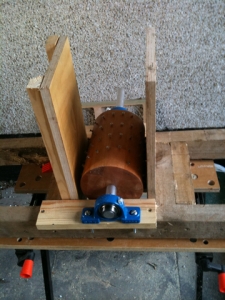This is the business end of the machine.

Ours is made out of beech worktop, several layers glued together and then turned to make a cylinder 200mm w x 150mm dia with a 25mm hole through the middle.
This is 2 sheets of A4 paper stuck together with a printout 471mm (ie π x 150) by 200mm that should match the area of the surface of the drum if it were unfolded.

The dots were done in Photoshop as follows:
Added 10mm per side border so we weren’t screwing into thin air, leaving 180mm of workable width. 5 screws across 180mm leaves a 45mm gap between each one. UK Cider Scratter rules are 5mm spacings across the drum, so that’s 9 steps to reach the next screw. The other rule is 2 cuts per 5mm per rotation so 9 steps should also take us halfway round (235.5mm) or one every ~ 26mm.
I set my paper size to 200mm wide x 471mm long, added a guide every 5mm across the top ruler then I changed the default grid size to 26mm. I selected “snap to grid” and “snap to guide” and then picked a fairly big pencil in the pencil tool and went diagonally downwards from each starting dot plopping one on the intersection of the Vertical guides and horizontal gridlines.
Finally I stuck 2 pieces of A4 together and printed it out on my inkjet.

This what it looks like printed out and stuck around the drum. Gorgeous!
Finally I used a nail punch and a hammer to strike a little hole at each dot, removed the template and marvelled at the fact that schoolboy geometry and sub-basic photoshop had combined to solve a real world problem. What are the chances of that happening, eh?














